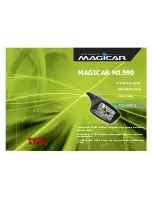
Technical Bulletin
SuperDuct Four-Wire Duct Smoke Detector
7
Multiple duct detector operation
The interconnect feature of the SuperDuct duct smoke detector
lets you connect up to 15 SuperDuct duct smoke detectors to
each other, typically for multiple fan shutdown applications.
When one of the duct smoke detectors goes into alarm, it
operates as described above. On the remaining duct smoke
detectors not in alarm, only the following occurs:
•
The auxiliary relay contacts switch positions
•
The remote LED output is activated (turned on)
Duct detector installation
Installation guidelines
To ensure correct operation, install the duct detector using the
following guidelines:
•
Locate the sensor so its sampling tube is positioned in a
straight length of square duct between six and ten duct
widths from any bends or obstructions as shown in the
diagram below. See Figure 12 for sensor and controller
dimensions.
6 to 10 duct widths
1 duct
width
Bend or other
obstruction
Airflow
•
For detection of smoke in the supply air system, install a
duct smoke detector in the supply air duct at a point
downstream from the supply fan and air filters
•
For detection of smoke in the return air system, install a
duct smoke detector in the return air duct at a point before
the return air stream is diluted by outside air
•
Extend sampling tubes at least two-thirds across the width
of the HVAC duct with the air inlet holes pointed into the
direction of airflow
•
Support sampling tubes longer than 3 feet at the end
farthest from the sensor to avoid excessive vibration
•
Upon installation perform an air pressure differential test
to ensure the sensor is capable of sampling the air stream
Wiring guidelines
•
Do not loop wiring under screw terminals. Always break
wire runs to ensure proper connection supervision.
•
Run all field wiring to the controller through the
knockouts located at the bottom of the controller housing.
Maintain a 1/4-inch separation between power-limited
and nonpower-limited wiring at all times.
Installation sequence
The steps required to install the SuperDuct duct smoke
detector are described below. The order in which these steps
are performed may vary depending installation requirements.
1. Verify the duct airflow direction and velocity.
2. Drill the mounting holes.
3. Assemble
the
detector.
4. Mount the detector on the HVAC duct.
5. Verify the detector pressure differential.
You can install the SuperDuct duct smoke detector in any
position on a flat surface, as a single unit or with the sensor
and controller separated.
Changing sensor dirty test operation
By default, sensor dirty test results are indicated as follows:
•
The sensor’s Dirty LED flashes
•
The controller’s Trouble LED flashes
•
The controller’s supervision relay contacts toggle
You can change the operation of a sensor’s dirty test so that
the controller’s supervision relay is not used to indicate test
results. When two detectors are connected to a controller,
sensor dirty test operation on both sensors must be configured
to operate in the same manner.
Caution:
Changing the sensor dirty test operation will put the
duct detector into the alarm state and activate all automatic
alarm responses. Before changing sensor dirty test operation,
disconnect all auxiliary equipment from the controller and
notify the proper authorities if connected to a fire alarm
system.
To configure dirty test operation:
1. Hold the test magnet where indicated on the side of the
sensor housing until the sensor’s Alarm LED turns on and
its Dirty LED flashes twice (approximately 60 seconds).
2. Reset the sensor by removing the test magnet then
holding it against the sensor housing again until the
sensor’s Alarm LED turns off (approximately 2 seconds).


































